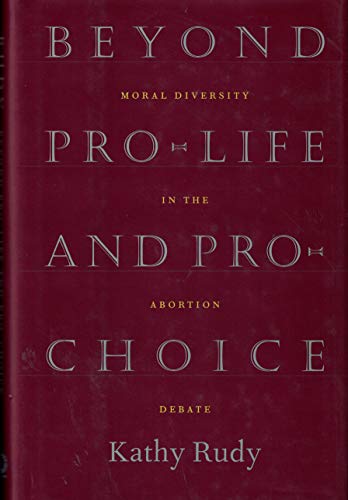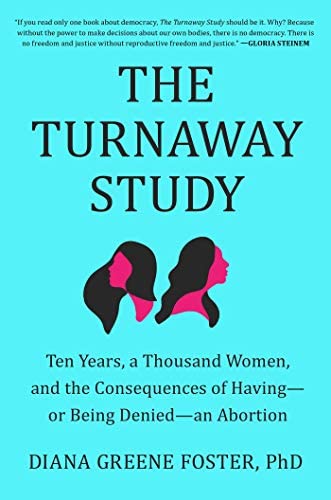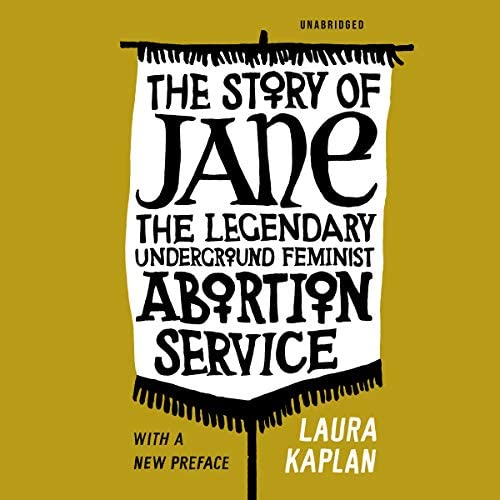My Reading Life: The Abortion Books, Part 2 (The Academic Books)
After almost six months, I’m wrapping up my self-directed abortion books study. Originally, I was going to talk about the books in the order I read them, but instead I decided to group them topically. I read three books that I would call “academic” treatments of abortion.
Beyond Pro-Life and Pro-Choice by Kathy Rudy
I acquired this book years ago when I did some work for a colleague and got paid, partly, in books. It appealed to me then because I’d come to feel out of touch with both the “pro-life” and the “pro-choice” movements. This book takes the premise that neither camps encompass the complicated or nuanced issue of abortion, arguing that we can’t really talk about abortion across this divide because abortion means different things to different groups. To pro-life Catholics, abortion means murder. To feminists, it means control of one’s body. These are gross oversimplifications, of course, but it’s these oversimplifications that inform our attempts at dialog across ideological differences.
One of my first thoughts when I started this was, “Oh boy, I’m out of practice reading academic texts.” Kathy Rudy’s writing style reads like a dissertation, which would be off-putting to anyone who isn’t used to reading in this style — or anyone who’s already done higher education and doesn’t really want to go back there. And that’s really a shame, because the central argument of this book and the solution it proposes to the abortion divide is one I would like to see more Americans get behind.
Rudy’s argument is that, since we’re not even talking about the same thing when we discuss abortion “across party lines,” we should stop fighting this battle in the legal arena. Abortion should be regulated by the medical community, not the legal system. And those who hold strong convictions about abortion should put their energy into converting others to their way of thinking, not changing laws.
Ultimately, what this means is that those who have a strong moral conviction against abortion need to put their energy into making birthing and possibly raising a child an appealing option. That entails creating a culture in which children, and just as importantly, those who raise them feel fully embraced, supported, and celebrated. The American culture lacks this value system and does very little to support mothers and families; as such, if you hold a strong moral conviction that every or nearly every conception should result in birth, then the onus falls to you to create subcultures within our country that offer generous support for women facing crisis pregnancies. Right now, too much of the response to crisis pregnancies from the pro-life community is a few boxes of free diapers and a boatload of shame and guilt for contemplating abortion.
Essentially, focusing on the legal battle allows those who are pro-life to let themselves off the hook easily when it comes to crisis pregnancies. If abortion is illegal (as it now is in my state), they’ve satisfied their moral obligation to save embryos and fetuses. They can walk away feeling morally superior while women and children continue to suffer. Taking the abortion debate out of the legal arena forces those who feel strongly about the choices of others to put some skin of their own in the game — and if you aren’t willing to do that, please step away from the pregnant woman.
The Turnaway Study by Diana Greene Foster
[T]his study is about the lives of women and children and how they are affected by access to abortion services. I am not attempting to engage in a moral or political argument, though people will, of course, bring their own beliefs and perspectives to the issue of abortion. But it is important for our opinions to be grounded in an accurate understanding of reality.
– Diana Greene Foster, PhD, The Turnaway Study, emphasis mine
Everyone who deigns to make laws governing abortion should read this book.
The study design is brilliant. It followed 1,000 women over ten years who either received a wanted abortion, or were denied a wanted abortion because they arrived after the clinic’s gestational cutoff date. It then compared outcomes across the two groups on a variety of factors, such as economic stability, relationship satisfaction, goal attainment, etc.
Something that is worth noting is that the vast majority of women in the group that were denied an abortion said they did not regret carrying the pregnancy to term. The vast majority of women in the group that received an abortion also said they did not regret that outcome. While people in both camps might try to claim the side they’d like to support their own stance on abortion, what the study really revealed is that women are resilient, and able to make peace with the lot life hands them.
Another important point of note is that when women cited particular reasons for wanting the abortion, such as lack of economic security or an unhealthy relationship with the father, they were pretty much always right in the fears they had for their life and the life of the unborn child. That is, women who feared not being able to afford a child (or another child) did, in fact, suffer greater economic hardship after carrying an unwanted pregnancy to term than those who received their sought-after abortions. Women who felt their relationships were not stable enough to support a child saw those same relationships fall apart within the next year or two in most cases. Women are remarkably astute at foreseeing the challenges that they face and making the best decisions for themselves and their families. Which is why we would all do well to trust them with those decisions.
And if you still feel you have a moral obligation to reduce abortions, this book offers some pretty clear targets for where activists should be focusing their energy.
- Women get abortions for economic reasons. They get them because they can’t afford to financially support a child, either because they do not earn enough, do not have a safety net, or cannot afford to take the time off work required to give birth and recover, not to mention the cut to productivity that comes from sleep deprivation, taking time off work to care for sick children, etc. A financial safety net for families that included guaranteed paid maternity leave, high-quality subsidized childcare, or help attaining necessities such as housing and food are just a few programs that should be top priority for those who oppose abortion.
- Women get abortions because they do not want to be trapped in unhealthy relationships. Women who did not receive a desired abortion in the Turnaway Study were more likely to be raising children alone at the five-year mark. They needed to exit the unstable relationship for their and their child’s good, but because the child tied them together, it often took longer to extricate themselves. Women who received the desired abortion cut ties to the unhealthy relationship much more quickly, freeing them up to pursue healthier relationships in which they could raise their future children. So if children growing up in stable, two-parent homes is high on your “family values” checklist, denying women access to abortion actually impedes such relationships. If you want to strengthen the traditional family unit (two parents, children) AND reduce abortions, support programs that make it easier for women and children to leave toxic relationships. This could take the form of better access to domestic violence shelters, grants or loans to help financially dependent women leave abusive partners, or free mental health support and counseling for those in foundering relationships.
- Women get abortions because they feel they do not have the emotional or mental wherewithal to raise a child. If you want to reduce abortion, support low-cost or free access to high-quality mental health treatment for girls and women before they find themselves facing a crisis pregnancy. The Body Keeps the Score by Bessel A. van der Kolk is an important primer on the lifelong (and inter generational) effects of trauma for anyone who doubts the importance of shoring up parental mental health.
Also, somewhat counterintuitively, access to abortion actually increases the number of children women bear. Women who were denied abortion were more likely to follow the birth of their baby with tubal ligation, whereas women who received their abortions often went on to have additional children when their situation stabilized. So if you want babies for babies’ sake, abortion access supports that. If you, like me, want all children to be wanted children who have the best chance possible of a stable upbringing, abortion access is crucial.
A note on adoption as the solution to crisis pregnancies: in the study, the women who placed a child for adoption were the only ones to consistently express regret about their decision. They were also unlikely to make the same choice with subsequent pregnancies.
The study also exposes that abortion restrictions based on making the procedure “safer” are complete hogwash. The complication rate for abortion is extremely low — women are about 14 times more likely to die from complications of giving birth than to die from a medical abortion. That doesn’t even take into account the myriad stresses and dangers pregnancy poses to women who survive it. (Pre-eclampsia, gestational diabetes, and hemorrhage, to name a couple of the most frequent offenders.)
After reading this book, essentially the only argument one can make against abortion is a moral one. There is no justification for continuing to legislate based on straw-man arguments related to women’s health (mental or physical), familial stability, or “love of children.” Those who oppose abortion on a moral basis are entitled to their convictions. Let’s just be honest about the arguments we’re making.
The Story of Jane by Laura Kaplan
I considered categorizing this history of the Jane Collective in Chicago — an underground abortion referral and provider network that operated from 1969-1973 — under personal stories because it was written by a member of the collective. But it is a journalistic history based on interviews, primary documents, and research. It is not a memoir, and the writer does not disclose who she “was” until the afterward in the book. (All Jane members are given pseudonyms.)
Even though this network operated before I was even born, I found quite a bit of information that remains relevant to the current conversation on abortion rights — particularly since many states have been flung back fifty years by the Dobbs decision. I can’t help but wonder if the extreme detail given in some sections of this book are meant to serve as a primer for those who may be motivated to revive such networks.
I found myself reflecting particularly on three points illustrated by the Jane collective.
- Abortion providers have a dangerous job. I was struck by how much the members of Jane were willing to risk for women to access abortion. Many Jane members had children who still lived at home, putting their entire family’s stability at risk if they faced criminal charges. While the police mostly looked the other way, there was a raid on the collective that resulted in charges against seven women. (The charges were dropped because Roe v. Wade passed before the women went to trial.) While we might want to believe that providers no longer take such risks in places where abortion is legal, this belief is unfortunately naive. Currently, abortion providers face death threats, harassment, and more in carrying out their jobs. Both the members of the Jane collective and doctors who currently provide abortion face considerable risk to themselves and their families.
- Abortion, apparently, is not rocket science. When the collective learned that their most trusted abortionist was not, in fact, a doctor, women in the collective took it upon themselves to learn how to perform safe, humane abortions. Fortunately, the collective had connections with sympathetic doctors who served as insurance if any complications arose. But complications were rare. The collective performed more than 10,000 abortions in their four years of operation, and not a single woman died as a result of a Jane abortion. We know, of course, that DIY abortions are incredibly dangerous — but abortions provided by someone trained in doing them safely are not, whether that person is an MD or not.
- The Janes provided women-centered healthcare the likes of which we rarely see within established medicine. Jane members engaged in emotional support and literal hand-holding before, during, and after the procedure. Women were given food and water during the brief post-procedure recovery period. They were able to talk with other women who were waiting for or recovering from an abortion. The abortionist talked them through the procedure so they knew what was happening and what to expect. When the collective dissolved in 1973, women who had subsequent legal abortions reported the medical abortions as being more traumatic than the Jane procedures. While our medical establishment may be slowly and begrudgingly moving toward more patient-centered care — a doula, privately paid for, was welcomed during both my births to provide this kind of “whole-person” care — receiving intimate medical care can still very much make you feel like just another body being shuttled through the system.
While these books provided compelling arguments and, more importantly, evidence, I know that statistics do not always stick with one the way that personal accounts do. That’s why I’ll soon turn to the treatment of the topic of abortion in fiction and the personal stories of those living in the midst of the abortion debate.


